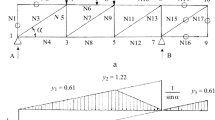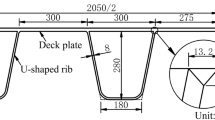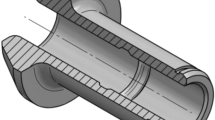Abstract
A hybrid algorithm based on the finite element method, Monte Carlo model, and Hall–Petch relationship is utilized to predict the mechanical properties of the rods after cold forging at different degrees of deformations and heat treatments at different temperatures and times. The results show that the flow stress and hardness of the rods after forging and those of the forged rods after the heat treatments are decreased from their center to surface. However, with increasing the temperature and time of the heat treatment the flow stress and hardness are decreased, their effects are not considerable. In addition, the distribution of the mechanical properties of the forged rods after the heat treatments is more uniform than the one before the heat treatments. Moreover, to verify the predicted results the hardness values of the rods after forging and heat treatment are measured experimentally and compared with the predicted ones.
Similar content being viewed by others
References
Semiatin SL, Jonas JJ (1984) Formability and workability of metals: plastic instability and flow localization. ASM, Materials Park
Altan T, Oh SI, Gegel HL (1983) Metal forming. ASM, Materials Park
Kelly A, Nicholson RB (1971) Strengthening methods in crystals. Applied Science Publishers, London
Humphreys FJ, Hatherly M (1995) Recrystallization and related annealing phenomena. Elsevier Science, Oxford
Kobayashi S, Oh SI, Altan T (1989) Metal forming and the finite element method. Oxford University Press, Oxford
Ding H, Hirai K, Homma T, Kamado S (2010) Numerical simulation for microstructure evolution in AM50 Mg alloy during hot rolling. Comput Mater Sci 47:919–925
Ren T, Shan D, Chen Y, Lu Y (2010) Surface plastic deformation distribution and microstructural evolution in the compound rolling of Ti–50Al billet. Mater Des 31:3457–3462
Sasaki TT, Barkey M, Thompson GB, Syarif Y, Fox D (2011) Microstructural evolution of copper clad steel bimetallic wire. Mater Sci Eng A 528:2974–2981
Tabor D (1951) The hardness of metal. Clarendon, Oxford
Stuwe HP, Padilha AF, Siciliano F Jr (2002) Competition between recovery and recrystallization. Mater Sci Eng A 333:361–367
Nayebi A, Bartier O, Mauvoisin G, El Abdi R (2001) New method to determine the mechanical properties of heat treated steels. Int J Mech Sci 43:2679–2697
Poole WJ, Ashby MF, Fleck NA (1996) Micro-hardness of annealed and work-hardened copper polycrystals. Scr Mater 34:559–564
Cotterill P, Mould PR (1976) Recrystallization and grain growth in metals. Surrey University Press, London
Christian JW (1965) The theory of transformations in metals and alloys. Pergamon, Oxford
Srolovitz DJ, Anderson MP, Grest GS, Sahni PS (1983) Grain growth in two dimensions. Scr Metall 17:241–246
Anderson MP, Srolovitz DJ, Grest GS, Sahni PS (1984) Computer simulation of grain growth—I. Kinetics. Acta Metall 32:783–791
Morhac M, Morhacova E (2000) Monte carlo simulation algorithms of grain growth in polycrystalline materials. Cryst Res Technol 35:117–128
Mandal D, Baker I (1995) Determination of the stored energy and recrystallization temperature as a function of depth after rolling of polycrystalline copper. Scr Metall Mater 33:645–650
Mohamed G, Bacroix B (2000) Role of stored energy in static recrystallization of cold rolled copper single and multicrystals. Acta Mater 48:3295–3302
McElroy RJ, Szkopiak ZC (1972) Dislocation substructure strengthening and mechanical treatment of metals. Int Metall Rev 17:175–202
Mecking H, Kocks UF (1981) Kinetic of flow stress and strain hardening. Acta Metall 29:1865–1875
Kazeminezhad M, Karimi Taheri A, Kiet Tieu A (2007) Utilization of the finite element and Monte Carlo model for simulating the recrystallization of inhomogeneous deformation of copper. Comput Mater Sci 38:765–773
Srolovitz DJ, Grest GS, Anderson MP (1986) Computer simulation of recrystallization—I. Homogeneous nucleation and growth. Acta Metall 34:1833–1845
Rollett AD (1997) Overview of modeling and simulation of recrystallization. Prog Mater Sci 42:79–99
Rollett AD, Srolovitz DJ, Doherty RD, Anderson MP (1989) Computer simulation of recrystallization in non-uniformly deformed metals. Acta Metall 37:627–639
Lim YY, Chaudhri MM (2002) The influence of grain size on the indentation hardness of high-purity copper and aluminum. Phi Mag A 82:2071–2080
Author information
Authors and Affiliations
Corresponding author
Rights and permissions
About this article
Cite this article
Kazeminezhad, M. Prediction of the mechanical properties of rods after cold forging and heat treatment. Int J Adv Manuf Technol 69, 2071–2079 (2013). https://doi.org/10.1007/s00170-013-5189-1
Received:
Accepted:
Published:
Issue Date:
DOI: https://doi.org/10.1007/s00170-013-5189-1




